History 270: Polish Immigrants in United States After WWII
VerifiedAdded on 2022/09/22
|8
|1742
|26
Report
AI Summary
This report investigates the condition of Polish immigrants in the United States after World War II, focusing on the Chicago area, which had a large Polish population. It analyzes the challenges faced by these immigrants, drawing on secondary research articles to explore issues such as education, ethnic tensions, and acculturation. The report examines the educational challenges faced by Polish immigrants, particularly in the context of the Catholic school system dominated by Irish descendants. It also explores the acculturation process of Polish immigrants and the conflicts that arose between different ethnic groups and generations. Furthermore, it discusses the intragroup dynamics of Polish immigration, highlighting the distinction between immigrants and ethnics and the impact of these dynamics on the Polish American community. The report also reviews the musical self-representation of Polish-Americans, highlighting the conflicts and changes in their cultural identity. The analysis considers the impact of immigration on the US economy and culture, and suggests the need for further research on the long-term effects of Polish immigration.
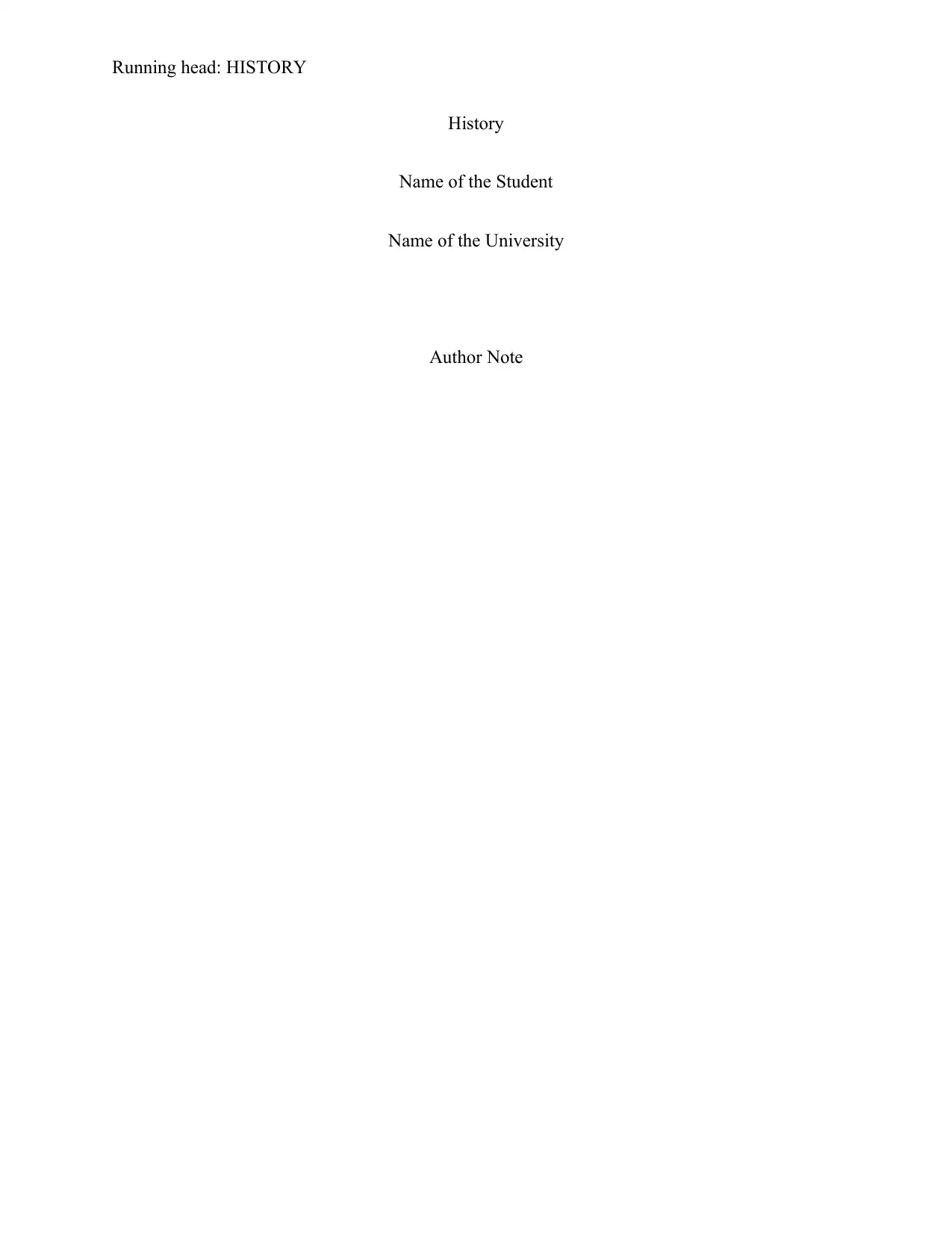
Running head: HISTORY
History
Name of the Student
Name of the University
Author Note
History
Name of the Student
Name of the University
Author Note
Paraphrase This Document
Need a fresh take? Get an instant paraphrase of this document with our AI Paraphraser
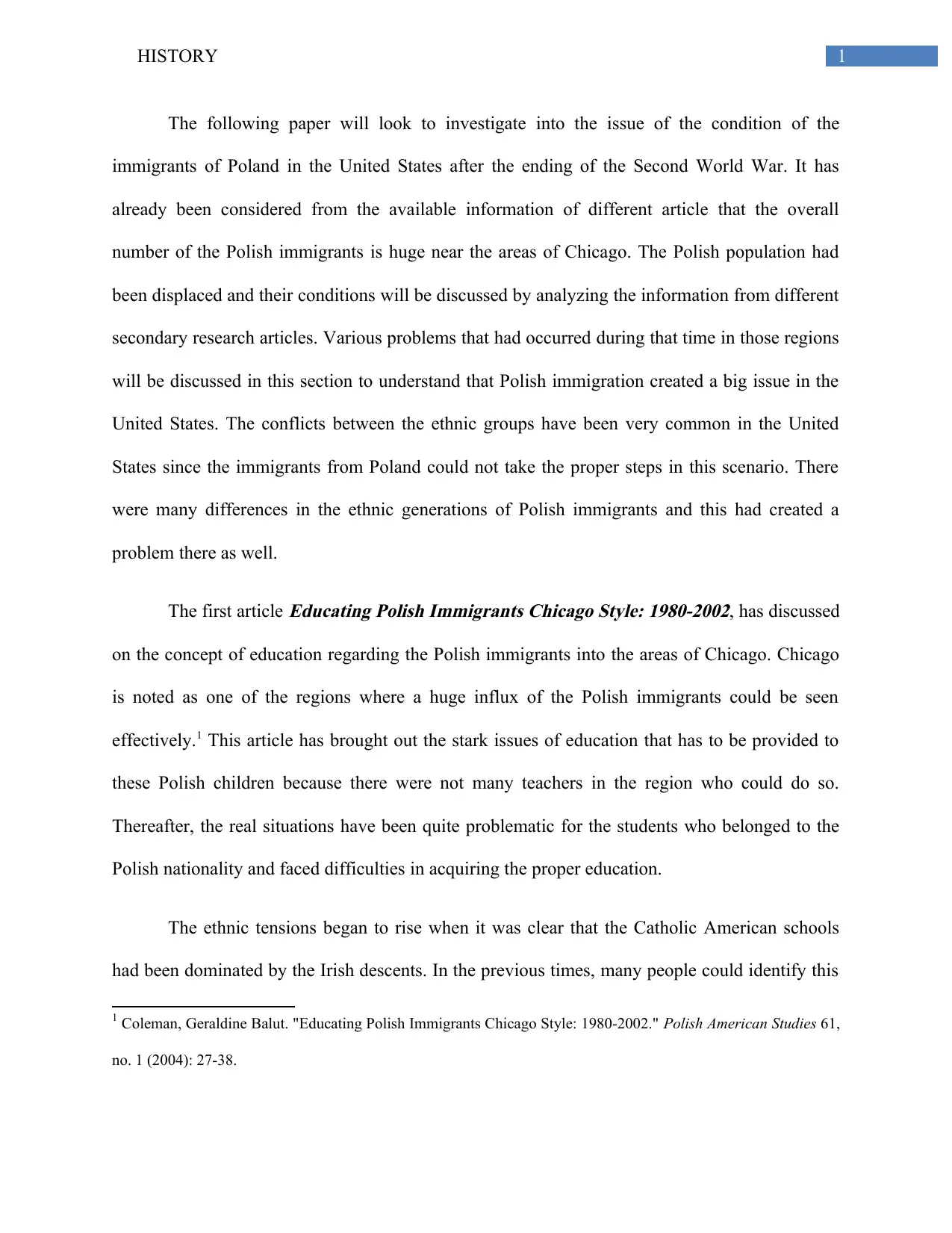
1HISTORY
The following paper will look to investigate into the issue of the condition of the
immigrants of Poland in the United States after the ending of the Second World War. It has
already been considered from the available information of different article that the overall
number of the Polish immigrants is huge near the areas of Chicago. The Polish population had
been displaced and their conditions will be discussed by analyzing the information from different
secondary research articles. Various problems that had occurred during that time in those regions
will be discussed in this section to understand that Polish immigration created a big issue in the
United States. The conflicts between the ethnic groups have been very common in the United
States since the immigrants from Poland could not take the proper steps in this scenario. There
were many differences in the ethnic generations of Polish immigrants and this had created a
problem there as well.
The first article
Educating Polish Immigrants Chicago Style: 1980-2002, has discussed
on the concept of education regarding the Polish immigrants into the areas of Chicago. Chicago
is noted as one of the regions where a huge influx of the Polish immigrants could be seen
effectively.1 This article has brought out the stark issues of education that has to be provided to
these Polish children because there were not many teachers in the region who could do so.
Thereafter, the real situations have been quite problematic for the students who belonged to the
Polish nationality and faced difficulties in acquiring the proper education.
The ethnic tensions began to rise when it was clear that the Catholic American schools
had been dominated by the Irish descents. In the previous times, many people could identify this
1 Coleman, Geraldine Balut. "Educating Polish Immigrants Chicago Style: 1980-2002." Polish American Studies 61,
no. 1 (2004): 27-38.
The following paper will look to investigate into the issue of the condition of the
immigrants of Poland in the United States after the ending of the Second World War. It has
already been considered from the available information of different article that the overall
number of the Polish immigrants is huge near the areas of Chicago. The Polish population had
been displaced and their conditions will be discussed by analyzing the information from different
secondary research articles. Various problems that had occurred during that time in those regions
will be discussed in this section to understand that Polish immigration created a big issue in the
United States. The conflicts between the ethnic groups have been very common in the United
States since the immigrants from Poland could not take the proper steps in this scenario. There
were many differences in the ethnic generations of Polish immigrants and this had created a
problem there as well.
The first article
Educating Polish Immigrants Chicago Style: 1980-2002, has discussed
on the concept of education regarding the Polish immigrants into the areas of Chicago. Chicago
is noted as one of the regions where a huge influx of the Polish immigrants could be seen
effectively.1 This article has brought out the stark issues of education that has to be provided to
these Polish children because there were not many teachers in the region who could do so.
Thereafter, the real situations have been quite problematic for the students who belonged to the
Polish nationality and faced difficulties in acquiring the proper education.
The ethnic tensions began to rise when it was clear that the Catholic American schools
had been dominated by the Irish descents. In the previous times, many people could identify this
1 Coleman, Geraldine Balut. "Educating Polish Immigrants Chicago Style: 1980-2002." Polish American Studies 61,
no. 1 (2004): 27-38.
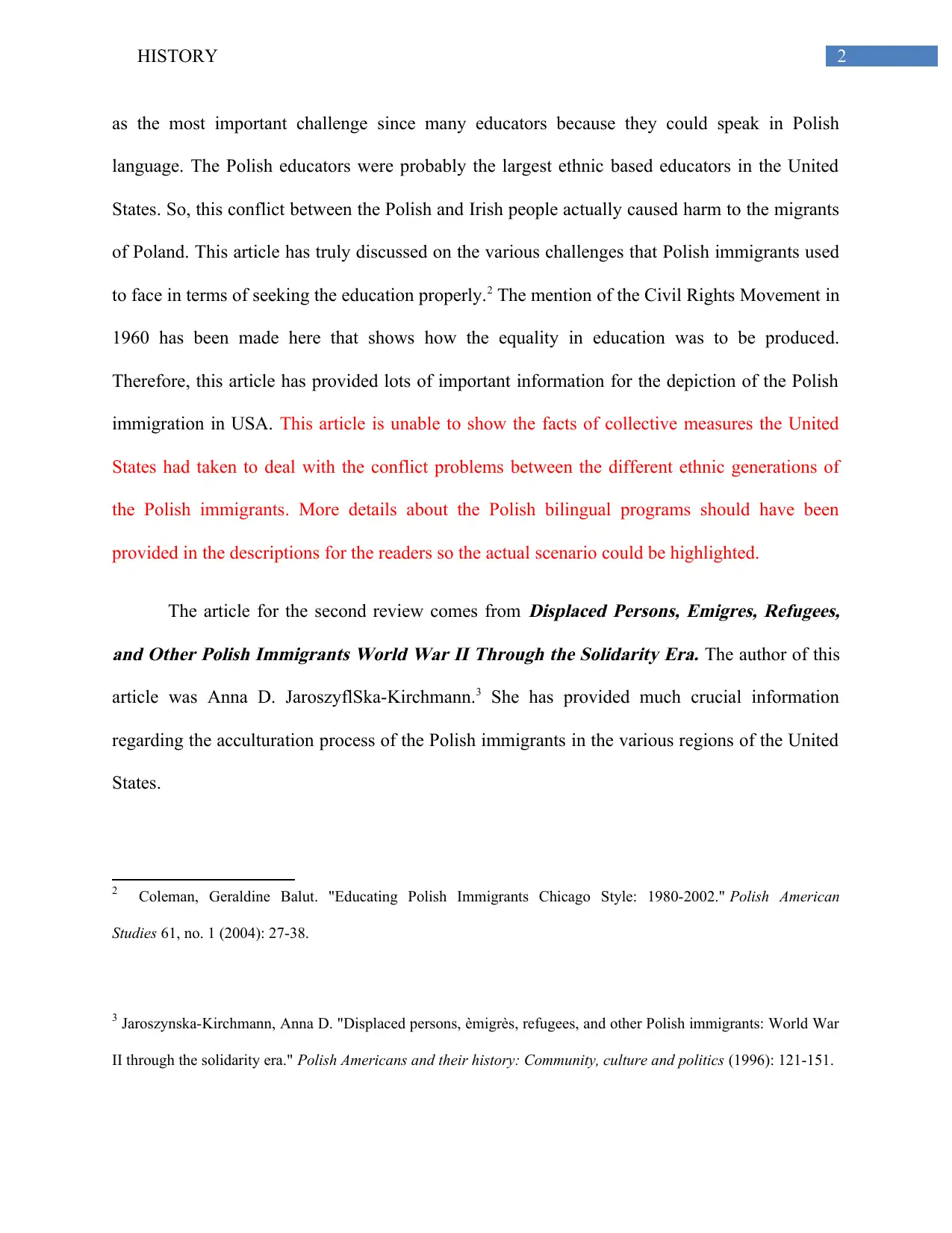
2HISTORY
as the most important challenge since many educators because they could speak in Polish
language. The Polish educators were probably the largest ethnic based educators in the United
States. So, this conflict between the Polish and Irish people actually caused harm to the migrants
of Poland. This article has truly discussed on the various challenges that Polish immigrants used
to face in terms of seeking the education properly.2 The mention of the Civil Rights Movement in
1960 has been made here that shows how the equality in education was to be produced.
Therefore, this article has provided lots of important information for the depiction of the Polish
immigration in USA. This article is unable to show the facts of collective measures the United
States had taken to deal with the conflict problems between the different ethnic generations of
the Polish immigrants. More details about the Polish bilingual programs should have been
provided in the descriptions for the readers so the actual scenario could be highlighted.
The article for the second review comes from
Displaced Persons, Emigres, Refugees,
and Other Polish Immigrants World War II Through the Solidarity Era. The author of this
article was Anna D. JaroszyflSka-Kirchmann.3 She has provided much crucial information
regarding the acculturation process of the Polish immigrants in the various regions of the United
States.
2 Coleman, Geraldine Balut. "Educating Polish Immigrants Chicago Style: 1980-2002." Polish American
Studies 61, no. 1 (2004): 27-38.
3 Jaroszynska-Kirchmann, Anna D. "Displaced persons, èmigrès, refugees, and other Polish immigrants: World War
II through the solidarity era." Polish Americans and their history: Community, culture and politics (1996): 121-151.
as the most important challenge since many educators because they could speak in Polish
language. The Polish educators were probably the largest ethnic based educators in the United
States. So, this conflict between the Polish and Irish people actually caused harm to the migrants
of Poland. This article has truly discussed on the various challenges that Polish immigrants used
to face in terms of seeking the education properly.2 The mention of the Civil Rights Movement in
1960 has been made here that shows how the equality in education was to be produced.
Therefore, this article has provided lots of important information for the depiction of the Polish
immigration in USA. This article is unable to show the facts of collective measures the United
States had taken to deal with the conflict problems between the different ethnic generations of
the Polish immigrants. More details about the Polish bilingual programs should have been
provided in the descriptions for the readers so the actual scenario could be highlighted.
The article for the second review comes from
Displaced Persons, Emigres, Refugees,
and Other Polish Immigrants World War II Through the Solidarity Era. The author of this
article was Anna D. JaroszyflSka-Kirchmann.3 She has provided much crucial information
regarding the acculturation process of the Polish immigrants in the various regions of the United
States.
2 Coleman, Geraldine Balut. "Educating Polish Immigrants Chicago Style: 1980-2002." Polish American
Studies 61, no. 1 (2004): 27-38.
3 Jaroszynska-Kirchmann, Anna D. "Displaced persons, èmigrès, refugees, and other Polish immigrants: World War
II through the solidarity era." Polish Americans and their history: Community, culture and politics (1996): 121-151.
⊘ This is a preview!⊘
Do you want full access?
Subscribe today to unlock all pages.

Trusted by 1+ million students worldwide
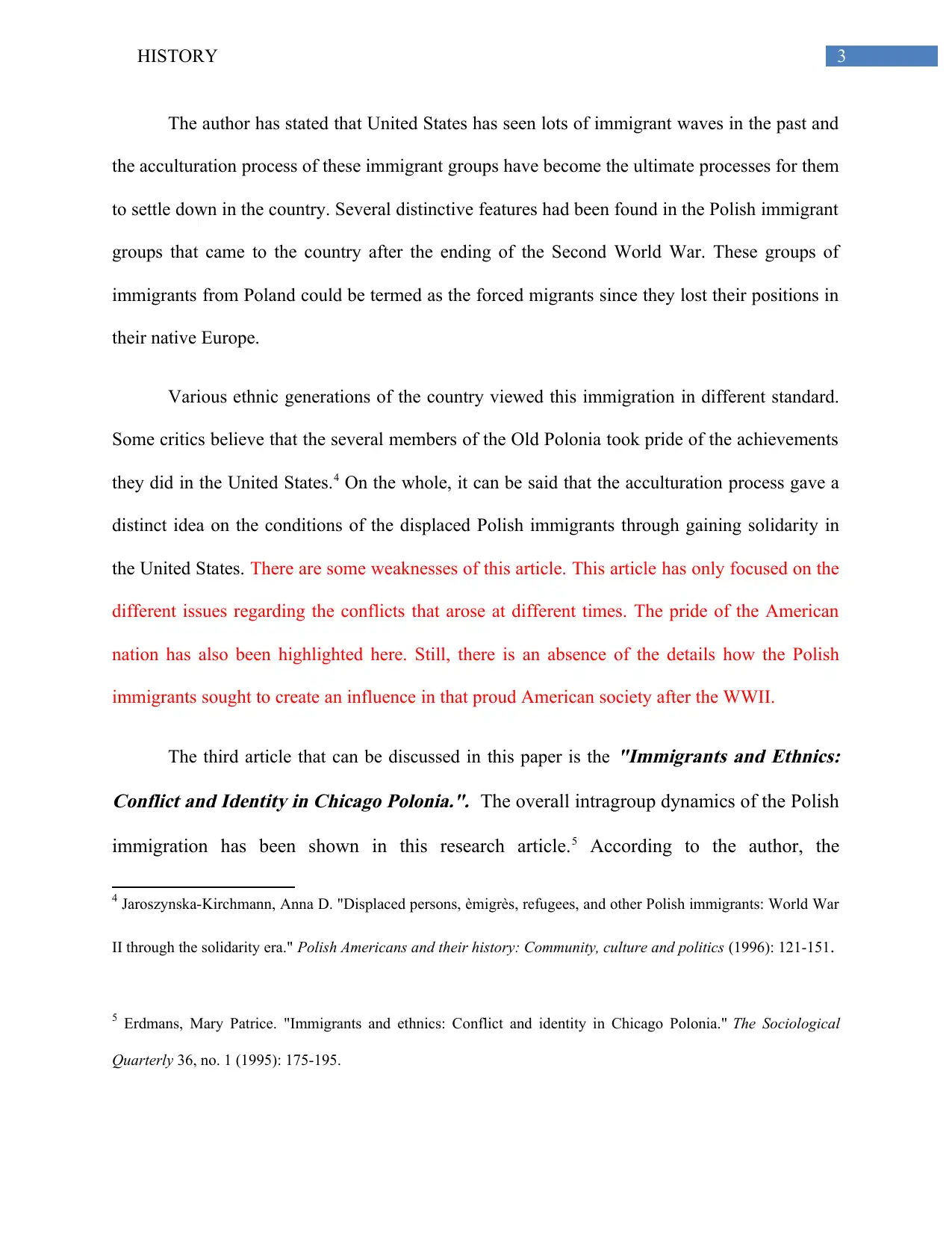
3HISTORY
The author has stated that United States has seen lots of immigrant waves in the past and
the acculturation process of these immigrant groups have become the ultimate processes for them
to settle down in the country. Several distinctive features had been found in the Polish immigrant
groups that came to the country after the ending of the Second World War. These groups of
immigrants from Poland could be termed as the forced migrants since they lost their positions in
their native Europe.
Various ethnic generations of the country viewed this immigration in different standard.
Some critics believe that the several members of the Old Polonia took pride of the achievements
they did in the United States.4 On the whole, it can be said that the acculturation process gave a
distinct idea on the conditions of the displaced Polish immigrants through gaining solidarity in
the United States. There are some weaknesses of this article. This article has only focused on the
different issues regarding the conflicts that arose at different times. The pride of the American
nation has also been highlighted here. Still, there is an absence of the details how the Polish
immigrants sought to create an influence in that proud American society after the WWII.
The third article that can be discussed in this paper is the
"Immigrants and Ethnics:
Conflict and Identity in Chicago Polonia.". The overall intragroup dynamics of the Polish
immigration has been shown in this research article.5 According to the author, the
4 Jaroszynska-Kirchmann, Anna D. "Displaced persons, èmigrès, refugees, and other Polish immigrants: World War
II through the solidarity era." Polish Americans and their history: Community, culture and politics (1996): 121-151.
5 Erdmans, Mary Patrice. "Immigrants and ethnics: Conflict and identity in Chicago Polonia." The Sociological
Quarterly 36, no. 1 (1995): 175-195.
The author has stated that United States has seen lots of immigrant waves in the past and
the acculturation process of these immigrant groups have become the ultimate processes for them
to settle down in the country. Several distinctive features had been found in the Polish immigrant
groups that came to the country after the ending of the Second World War. These groups of
immigrants from Poland could be termed as the forced migrants since they lost their positions in
their native Europe.
Various ethnic generations of the country viewed this immigration in different standard.
Some critics believe that the several members of the Old Polonia took pride of the achievements
they did in the United States.4 On the whole, it can be said that the acculturation process gave a
distinct idea on the conditions of the displaced Polish immigrants through gaining solidarity in
the United States. There are some weaknesses of this article. This article has only focused on the
different issues regarding the conflicts that arose at different times. The pride of the American
nation has also been highlighted here. Still, there is an absence of the details how the Polish
immigrants sought to create an influence in that proud American society after the WWII.
The third article that can be discussed in this paper is the
"Immigrants and Ethnics:
Conflict and Identity in Chicago Polonia.". The overall intragroup dynamics of the Polish
immigration has been shown in this research article.5 According to the author, the
4 Jaroszynska-Kirchmann, Anna D. "Displaced persons, èmigrès, refugees, and other Polish immigrants: World War
II through the solidarity era." Polish Americans and their history: Community, culture and politics (1996): 121-151.
5 Erdmans, Mary Patrice. "Immigrants and ethnics: Conflict and identity in Chicago Polonia." The Sociological
Quarterly 36, no. 1 (1995): 175-195.
Paraphrase This Document
Need a fresh take? Get an instant paraphrase of this document with our AI Paraphraser
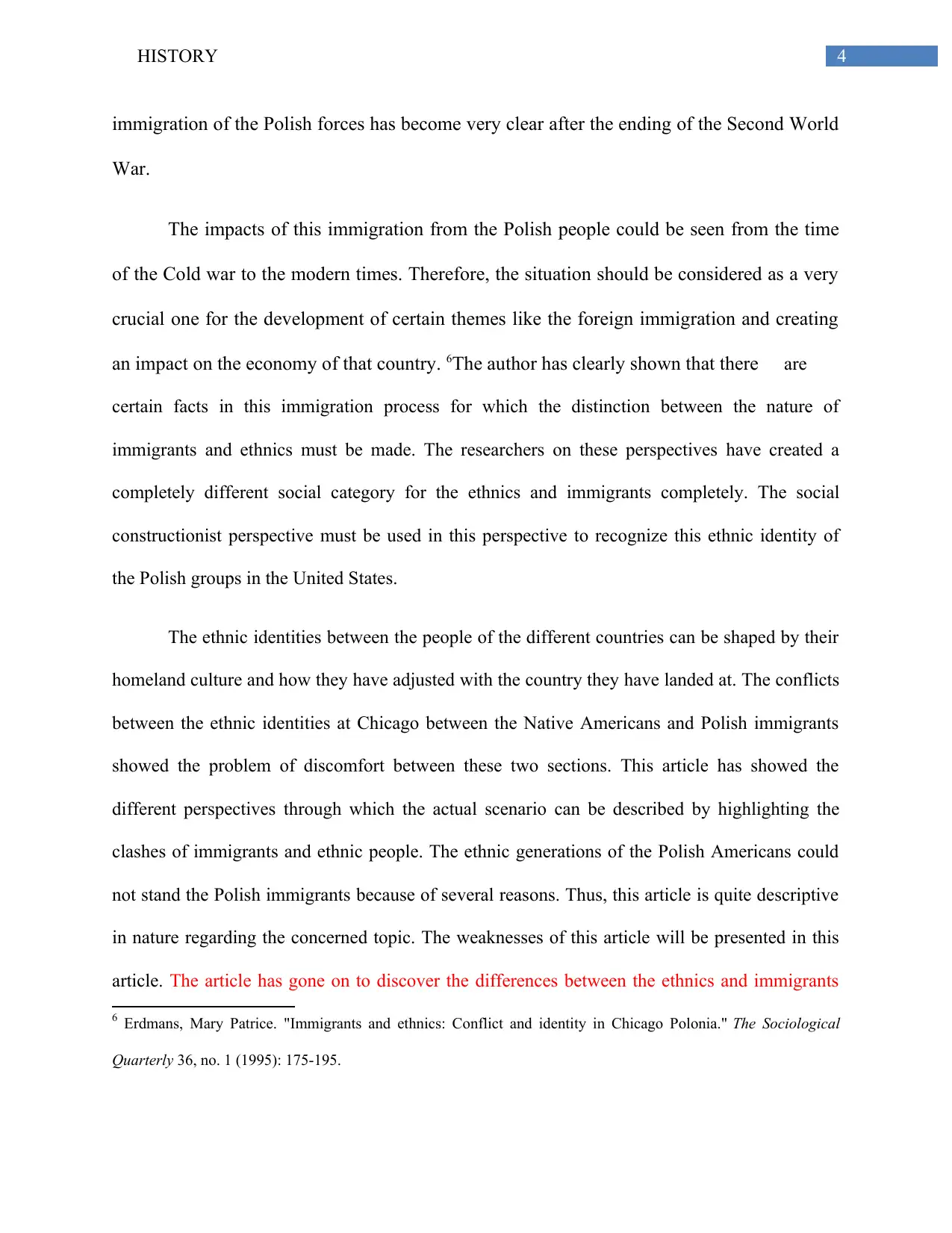
4HISTORY
immigration of the Polish forces has become very clear after the ending of the Second World
War.
The impacts of this immigration from the Polish people could be seen from the time
of the Cold war to the modern times. Therefore, the situation should be considered as a very
crucial one for the development of certain themes like the foreign immigration and creating
an impact on the economy of that country. 6The author has clearly shown that there are
certain facts in this immigration process for which the distinction between the nature of
immigrants and ethnics must be made. The researchers on these perspectives have created a
completely different social category for the ethnics and immigrants completely. The social
constructionist perspective must be used in this perspective to recognize this ethnic identity of
the Polish groups in the United States.
The ethnic identities between the people of the different countries can be shaped by their
homeland culture and how they have adjusted with the country they have landed at. The conflicts
between the ethnic identities at Chicago between the Native Americans and Polish immigrants
showed the problem of discomfort between these two sections. This article has showed the
different perspectives through which the actual scenario can be described by highlighting the
clashes of immigrants and ethnic people. The ethnic generations of the Polish Americans could
not stand the Polish immigrants because of several reasons. Thus, this article is quite descriptive
in nature regarding the concerned topic. The weaknesses of this article will be presented in this
article. The article has gone on to discover the differences between the ethnics and immigrants
6 Erdmans, Mary Patrice. "Immigrants and ethnics: Conflict and identity in Chicago Polonia." The Sociological
Quarterly 36, no. 1 (1995): 175-195.
immigration of the Polish forces has become very clear after the ending of the Second World
War.
The impacts of this immigration from the Polish people could be seen from the time
of the Cold war to the modern times. Therefore, the situation should be considered as a very
crucial one for the development of certain themes like the foreign immigration and creating
an impact on the economy of that country. 6The author has clearly shown that there are
certain facts in this immigration process for which the distinction between the nature of
immigrants and ethnics must be made. The researchers on these perspectives have created a
completely different social category for the ethnics and immigrants completely. The social
constructionist perspective must be used in this perspective to recognize this ethnic identity of
the Polish groups in the United States.
The ethnic identities between the people of the different countries can be shaped by their
homeland culture and how they have adjusted with the country they have landed at. The conflicts
between the ethnic identities at Chicago between the Native Americans and Polish immigrants
showed the problem of discomfort between these two sections. This article has showed the
different perspectives through which the actual scenario can be described by highlighting the
clashes of immigrants and ethnic people. The ethnic generations of the Polish Americans could
not stand the Polish immigrants because of several reasons. Thus, this article is quite descriptive
in nature regarding the concerned topic. The weaknesses of this article will be presented in this
article. The article has gone on to discover the differences between the ethnics and immigrants
6 Erdmans, Mary Patrice. "Immigrants and ethnics: Conflict and identity in Chicago Polonia." The Sociological
Quarterly 36, no. 1 (1995): 175-195.
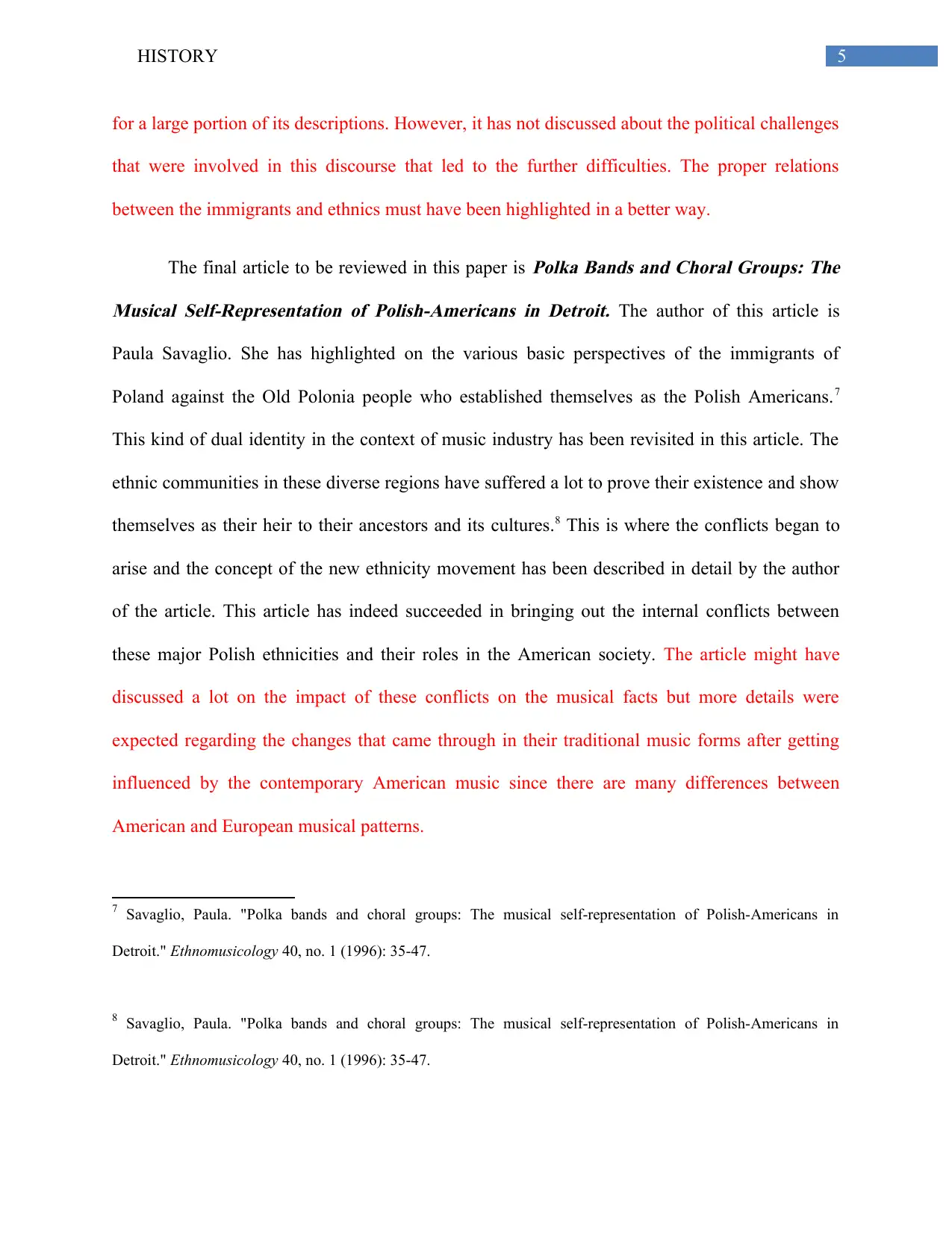
5HISTORY
for a large portion of its descriptions. However, it has not discussed about the political challenges
that were involved in this discourse that led to the further difficulties. The proper relations
between the immigrants and ethnics must have been highlighted in a better way.
The final article to be reviewed in this paper is
Polka Bands and Choral Groups: The
Musical Self-Representation of Polish-Americans in Detroit. The author of this article is
Paula Savaglio. She has highlighted on the various basic perspectives of the immigrants of
Poland against the Old Polonia people who established themselves as the Polish Americans.7
This kind of dual identity in the context of music industry has been revisited in this article. The
ethnic communities in these diverse regions have suffered a lot to prove their existence and show
themselves as their heir to their ancestors and its cultures.8 This is where the conflicts began to
arise and the concept of the new ethnicity movement has been described in detail by the author
of the article. This article has indeed succeeded in bringing out the internal conflicts between
these major Polish ethnicities and their roles in the American society. The article might have
discussed a lot on the impact of these conflicts on the musical facts but more details were
expected regarding the changes that came through in their traditional music forms after getting
influenced by the contemporary American music since there are many differences between
American and European musical patterns.
7 Savaglio, Paula. "Polka bands and choral groups: The musical self-representation of Polish-Americans in
Detroit." Ethnomusicology 40, no. 1 (1996): 35-47.
8 Savaglio, Paula. "Polka bands and choral groups: The musical self-representation of Polish-Americans in
Detroit." Ethnomusicology 40, no. 1 (1996): 35-47.
for a large portion of its descriptions. However, it has not discussed about the political challenges
that were involved in this discourse that led to the further difficulties. The proper relations
between the immigrants and ethnics must have been highlighted in a better way.
The final article to be reviewed in this paper is
Polka Bands and Choral Groups: The
Musical Self-Representation of Polish-Americans in Detroit. The author of this article is
Paula Savaglio. She has highlighted on the various basic perspectives of the immigrants of
Poland against the Old Polonia people who established themselves as the Polish Americans.7
This kind of dual identity in the context of music industry has been revisited in this article. The
ethnic communities in these diverse regions have suffered a lot to prove their existence and show
themselves as their heir to their ancestors and its cultures.8 This is where the conflicts began to
arise and the concept of the new ethnicity movement has been described in detail by the author
of the article. This article has indeed succeeded in bringing out the internal conflicts between
these major Polish ethnicities and their roles in the American society. The article might have
discussed a lot on the impact of these conflicts on the musical facts but more details were
expected regarding the changes that came through in their traditional music forms after getting
influenced by the contemporary American music since there are many differences between
American and European musical patterns.
7 Savaglio, Paula. "Polka bands and choral groups: The musical self-representation of Polish-Americans in
Detroit." Ethnomusicology 40, no. 1 (1996): 35-47.
8 Savaglio, Paula. "Polka bands and choral groups: The musical self-representation of Polish-Americans in
Detroit." Ethnomusicology 40, no. 1 (1996): 35-47.
⊘ This is a preview!⊘
Do you want full access?
Subscribe today to unlock all pages.

Trusted by 1+ million students worldwide
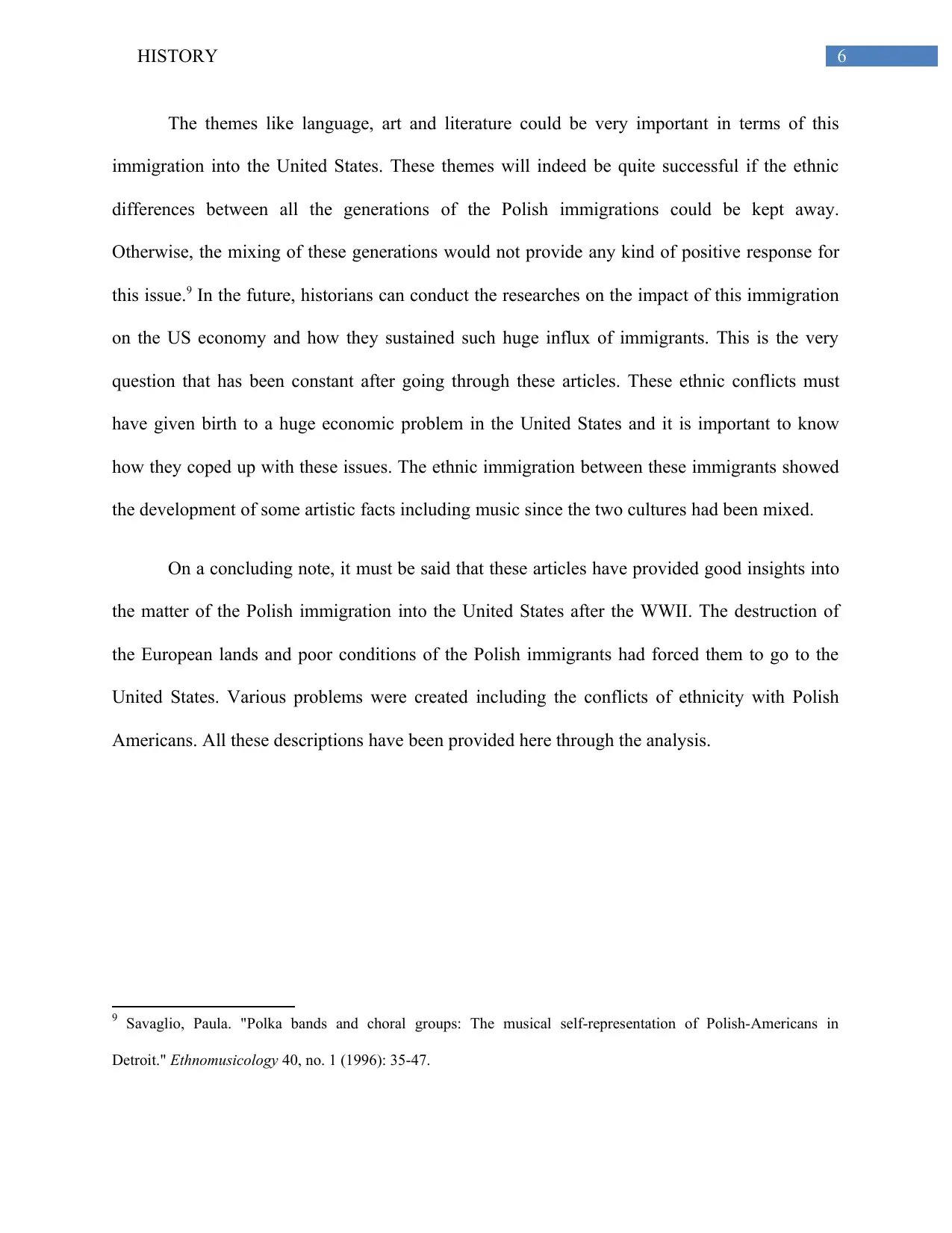
6HISTORY
The themes like language, art and literature could be very important in terms of this
immigration into the United States. These themes will indeed be quite successful if the ethnic
differences between all the generations of the Polish immigrations could be kept away.
Otherwise, the mixing of these generations would not provide any kind of positive response for
this issue.9 In the future, historians can conduct the researches on the impact of this immigration
on the US economy and how they sustained such huge influx of immigrants. This is the very
question that has been constant after going through these articles. These ethnic conflicts must
have given birth to a huge economic problem in the United States and it is important to know
how they coped up with these issues. The ethnic immigration between these immigrants showed
the development of some artistic facts including music since the two cultures had been mixed.
On a concluding note, it must be said that these articles have provided good insights into
the matter of the Polish immigration into the United States after the WWII. The destruction of
the European lands and poor conditions of the Polish immigrants had forced them to go to the
United States. Various problems were created including the conflicts of ethnicity with Polish
Americans. All these descriptions have been provided here through the analysis.
9 Savaglio, Paula. "Polka bands and choral groups: The musical self-representation of Polish-Americans in
Detroit." Ethnomusicology 40, no. 1 (1996): 35-47.
The themes like language, art and literature could be very important in terms of this
immigration into the United States. These themes will indeed be quite successful if the ethnic
differences between all the generations of the Polish immigrations could be kept away.
Otherwise, the mixing of these generations would not provide any kind of positive response for
this issue.9 In the future, historians can conduct the researches on the impact of this immigration
on the US economy and how they sustained such huge influx of immigrants. This is the very
question that has been constant after going through these articles. These ethnic conflicts must
have given birth to a huge economic problem in the United States and it is important to know
how they coped up with these issues. The ethnic immigration between these immigrants showed
the development of some artistic facts including music since the two cultures had been mixed.
On a concluding note, it must be said that these articles have provided good insights into
the matter of the Polish immigration into the United States after the WWII. The destruction of
the European lands and poor conditions of the Polish immigrants had forced them to go to the
United States. Various problems were created including the conflicts of ethnicity with Polish
Americans. All these descriptions have been provided here through the analysis.
9 Savaglio, Paula. "Polka bands and choral groups: The musical self-representation of Polish-Americans in
Detroit." Ethnomusicology 40, no. 1 (1996): 35-47.
Paraphrase This Document
Need a fresh take? Get an instant paraphrase of this document with our AI Paraphraser
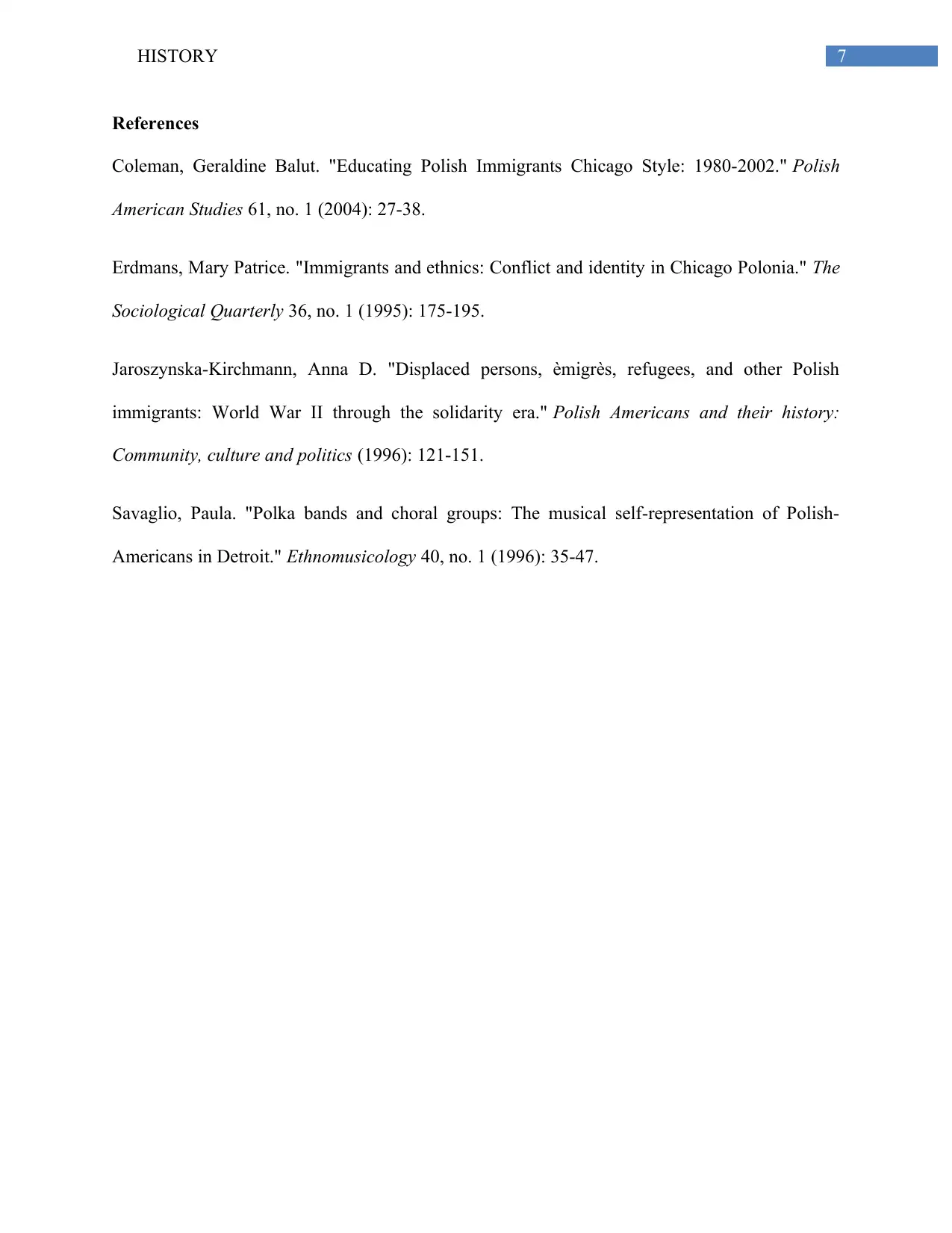
7HISTORY
References
Coleman, Geraldine Balut. "Educating Polish Immigrants Chicago Style: 1980-2002." Polish
American Studies 61, no. 1 (2004): 27-38.
Erdmans, Mary Patrice. "Immigrants and ethnics: Conflict and identity in Chicago Polonia." The
Sociological Quarterly 36, no. 1 (1995): 175-195.
Jaroszynska-Kirchmann, Anna D. "Displaced persons, èmigrès, refugees, and other Polish
immigrants: World War II through the solidarity era." Polish Americans and their history:
Community, culture and politics (1996): 121-151.
Savaglio, Paula. "Polka bands and choral groups: The musical self-representation of Polish-
Americans in Detroit." Ethnomusicology 40, no. 1 (1996): 35-47.
References
Coleman, Geraldine Balut. "Educating Polish Immigrants Chicago Style: 1980-2002." Polish
American Studies 61, no. 1 (2004): 27-38.
Erdmans, Mary Patrice. "Immigrants and ethnics: Conflict and identity in Chicago Polonia." The
Sociological Quarterly 36, no. 1 (1995): 175-195.
Jaroszynska-Kirchmann, Anna D. "Displaced persons, èmigrès, refugees, and other Polish
immigrants: World War II through the solidarity era." Polish Americans and their history:
Community, culture and politics (1996): 121-151.
Savaglio, Paula. "Polka bands and choral groups: The musical self-representation of Polish-
Americans in Detroit." Ethnomusicology 40, no. 1 (1996): 35-47.
1 out of 8
Related Documents
Your All-in-One AI-Powered Toolkit for Academic Success.
+13062052269
info@desklib.com
Available 24*7 on WhatsApp / Email
![[object Object]](/_next/static/media/star-bottom.7253800d.svg)
Unlock your academic potential
Copyright © 2020–2025 A2Z Services. All Rights Reserved. Developed and managed by ZUCOL.





